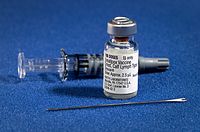
Photo from wikipedia
In this paper, we propose a mathematical model of tuberculosis with two treatments and exogenous re-infection, in which the treatment is effective for a number of infectious individuals and it… Click to show full abstract
In this paper, we propose a mathematical model of tuberculosis with two treatments and exogenous re-infection, in which the treatment is effective for a number of infectious individuals and it fails for some other infectious individuals who are being treated. We show that the model exhibits the phenomenon of backward bifurcation, where a stable disease-free equilibrium coexists with a stable endemic equilibria when the related basic reproduction number is less than unity. Also, it is shown that under certain conditions the model cannot exhibit backward bifurcation. Furthermore, it is shown in the absence of re-infection, the backward bifurcation phenomenon does not exist, in which the disease-free equilibrium of the model is globally asymptotically stable when the associated reproduction number is less than unity. The global asymptotic stability of the endemic equilibrium, when the associated reproduction number is greater than unity, is established using the geometric approach. Numerical simulations are presented to illustrate our main results.
Journal Title: International Journal of Biomathematics
Year Published: 2020
Link to full text (if available)
Share on Social Media: Sign Up to like & get
recommendations!